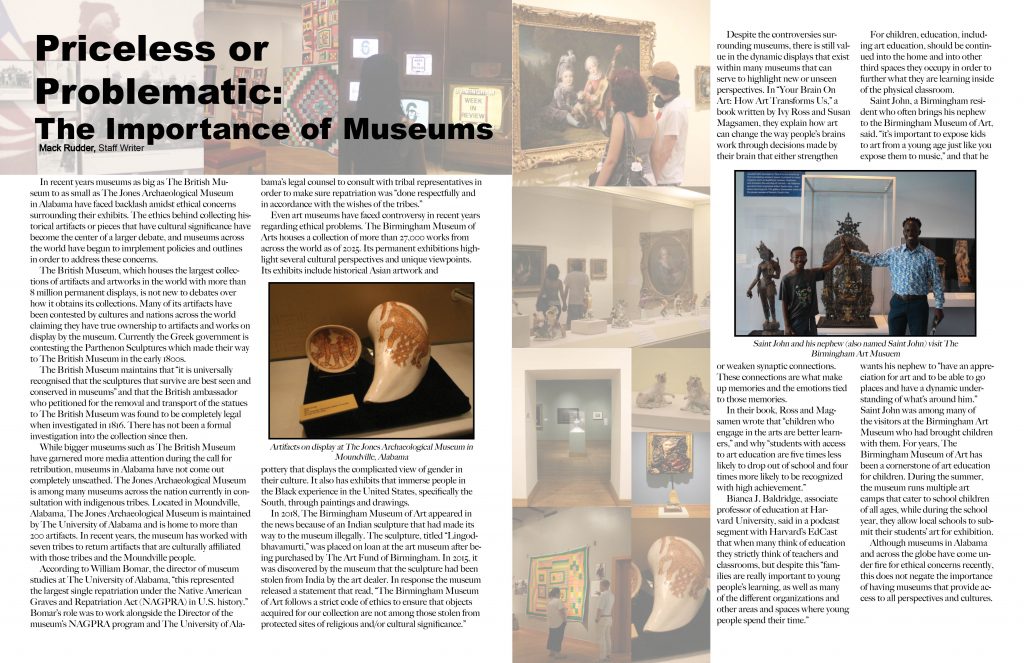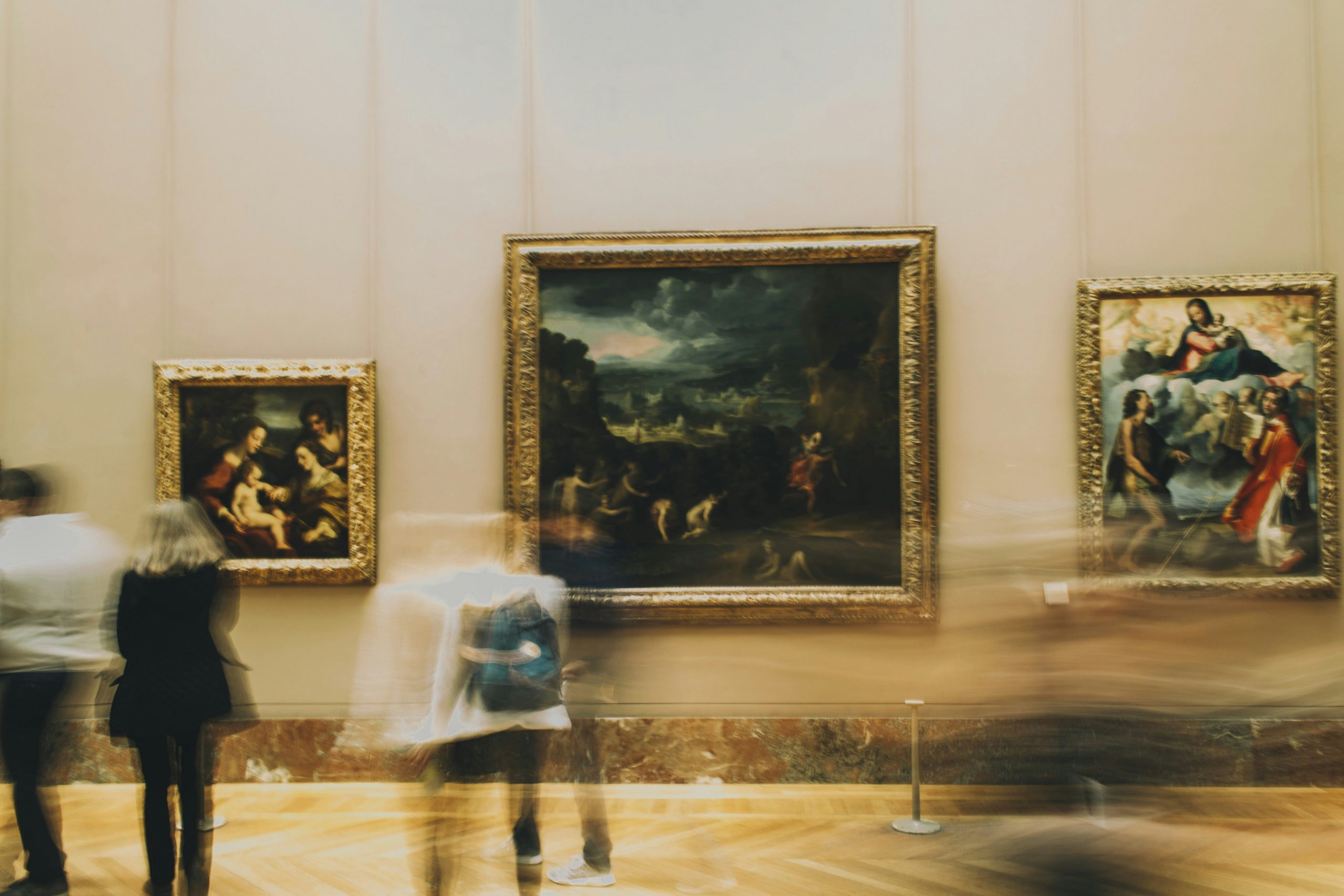The Importance of Museums
Story & Photos by: Mack Rudder
In recent years museums as big as The British Museum to as small as The Jones Archaeological Museum in Alabama have faced backlash amidst ethical concerns surrounding their exhibits. The ethics behind collecting historical artifacts or pieces that have cultural significance have become the center of a larger debate, and museums across the world have begun to implement policies and outlines in order to address these concerns.
The British Museum, which houses the largest collections of artifacts and artworks in the world with more than 8 million permanent displays, is not new to debates over how it obtains its collections. Many of its artifacts have been contested by cultures and nations across the world claiming they have true ownership to artifacts and works on display by the museum. Currently the Greek government is contesting the Parthenon Sculptures which made their way to The British Museum in the early 1800s.
The British Museum maintains that “it is universally recognised that the sculptures that survive are best seen and conserved in museums” and that the British ambassador who petitioned for the removal and transport of the statues to The British Museum was found to be completely legal when investigated in 1816. There has not been a formal investigation into the collection since then.
While bigger museums such as The British Museum have garnered more media attention during the call for retribution, museums in Alabama have not come out completely unscathed. The Jones Archaeological Museum is among many museums across the nation currently in consultation with indigenous tribes. Located in Moundville, Alabama, The Jones Archaeological Museum is maintained by The University of Alabama and is home to more than 200 artifacts. In recent years, the museum has worked with seven tribes to return artifacts that are culturally affiliated with those tribes and the Moundville people.
According to William Bomar, the director of museum studies at The University of Alabama, “this represented the largest single repatriation under the Native American Graves and Repatriation Act (NAGPRA) in U.S. history.”
Bomar’s role was to work alongside the director of the museum’s NAGPRA program and The University of Alabama’s legal counsel to consult with tribal representatives in order to make sure repatriation was “done respectfully and in accordance with the wishes of the tribes.”
Even art museums have faced controversy in recent years regarding ethical problems. The Birmingham Museum of Arts houses a collection of more than 27,000 works from across the world as of 2025. Its permanent exhibitions highlight several cultural perspectives and unique viewpoints. Its exhibits include historical Asian artwork and pottery that displays the complicated view of gender in their culture. It also has exhibits that immerse people in the Black experience in the United States, specifically the South, through paintings and drawings.
In 2018, The Birmingham Museum of Art appeared in the news because of an Indian sculpture that had made its way to the museum illegally. The sculpture, titled “Lingodbhavamurti,” was placed on loan at the art museum after being purchased by The Art Fund of Birmingham.
In 2015, it was discovered by the museum that the sculpture had been stolen from India by the art dealer. In response the museum released a statement that read, “The Birmingham Museum of Art follows a strict code of ethics to ensure that objects acquired for our collection are not among those stolen from protected sites of religious and/or cultural significance.”
Despite the controversies surrounding museums, there is still value in the dynamic displays that exist within many museums that can serve to highlight new or unseen perspectives. In “Your Brain On Art: How Art Transforms Us,” a book written by Ivy Ross and Susan Magsamen, they explain how art can change the way people’s brains work through decisions made by their brain that either strengthen or weaken synaptic connections. These connections are what make up memories and the emotions tied to those memories.
In their book, Ross and Magsamen wrote that “children who engage in the arts are better learners,” and why “students with access to art education are five times less likely to drop out of school and four times more likely to be recognized with high achievement.”
Bianca J. Baldridge, associate professor of education at Harvard University, said in a podcast segment with Harvard’s EdCast that when many think of education they strictly think of teachers and classrooms, but despite this “families are really important to young people’s learning, as well as many of the different organizations and other areas and spaces where young people spend their time.”
For children, education, including art education, should be continued into the home and into other third spaces they occupy in order to further what they are learning inside of the physical classroom.
Saint John, a Birmingham resident who often brings his nephew to the Birmingham Museum of Art, said, “it’s important to expose kids to art from a young age just like you expose them to music,” and that he wants his nephew to “have an appreciation for art and to be able to go places and have a dynamic understanding of what’s around him.”
Saint John was among many of the visitors at the Birmingham Art Museum who had brought children with them. For years, The Birmingham Museum of Art has been a cornerstone of art education for children. During the summer, the museum runs multiple art camps that cater to school children of all ages, while during the school year, they allow local schools to submit their students’ art for exhibition.
Although museums in Alabama and across the globe have come under fire for ethical concerns recently, this does not negate the importance of having museums that provide access to all perspectives and cultures.
Check out Mack’s spread below!

